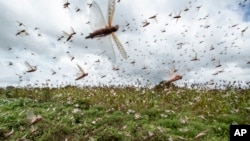The United Nations says urgent action must be taken to halt an invasion of locusts that is threatening food crops and livelihoods in the Horn of Africa.
A locust invasion is swarming across parts of Ethiopia, Somalia and Kenya, destroying crops and pastureland in its wake. The United Nations says this is the worst outbreak of its kind in 25 years for Ethiopia and Somalia, and the worst Kenya has seen in 70 years.
U.N. agencies warn the locusts are likely to spread even farther across East Africa unless immediate action is taken to rid the region of the pests.
Jens Laerke, spokesman for the Office for the Coordination of Humanitarian Affairs, told VOA the U.N. has released $10 million from its Central Emergency Response Fund to counter the outbreak.
"It is an early intervention to try to nip this in the bud," he said. "But it is clear that also the countries affected are very much alert on this and doing their best to prevent it from spreading any further."
Laerke said a lot more money than the initial U.N. contribution will be required to tackle the locust plague, which already is devastating the lives and livelihoods of thousands of people.
"This desert locust is among the most dangerous migratory pests in the world," he said. "A single locust can travel 150 kilometers and eat its own weight in food — about two grams — each day. A small swarm can consume the equivalent of food for 35,000 people in one day."
Aerial pesticide spraying is considered the best way to get rid of the locust swarms. U.N. officials say a large-scale spraying operation must begin now, before the rains start in March and the locust-breeding season begins.
The U.N. warns that locusts reproduce rapidly and, if left unchecked, their current numbers could grow 500 times by June, when the main cropping season gets under way.









